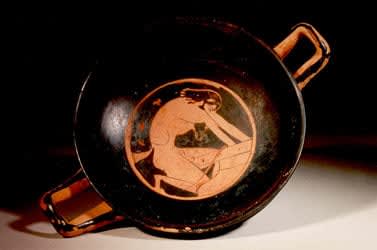Attic Red-Figure Kylix, 5 Century BCE
Terracotta
height 7.9 cm
height 3 1/8 in
height 3 1/8 in
X.0088
A kylix is a vessel with a wide mouth, a short, broad body that tapers into a footed base that was employed primarily for consuming wine. Handles on either side...
A kylix is a vessel with a wide mouth, a short, broad body that tapers into a footed base that was employed primarily for consuming wine. Handles on either side facilitate the raising and lowering of the vessel as the holder sips the contents. This gorgeous Attic red-figure kylix was likely used during a symposium, an Ancient Greek drinking banquet for men where the finest painted pottery vessels were utilized. Wine mixed with water would have filled the shallow bowl of the cup, and as the drinker finished the wine, the painted image as the bottom of the bowl would become visible.
Here, a long-haired satyr kneels on his right knee and reaches with both arms into a large pithos, shown only partially, from which he is undoubtedly drawing wine. In this action, the satyr is one step ahead of the drinker who must now attempt to refill his empty kylix. Scenes of revelry echoing the symposia are typical decorations for such vessels, and satyrs specifically symbolize the effects of the wine on the men, turning them into animals. A formidable composition, the arch of the satyr’s back echoes the frame of the painted scene and further emphasizes the roundness of the kylix. This particular shape kylix, with its off-set lip, is known to scholars as Type C, a shape that was relatively popular from around 490 to 460 B.C. and that was often painted black on the exterior without adornment, as is the case with this splendid work.
Here, a long-haired satyr kneels on his right knee and reaches with both arms into a large pithos, shown only partially, from which he is undoubtedly drawing wine. In this action, the satyr is one step ahead of the drinker who must now attempt to refill his empty kylix. Scenes of revelry echoing the symposia are typical decorations for such vessels, and satyrs specifically symbolize the effects of the wine on the men, turning them into animals. A formidable composition, the arch of the satyr’s back echoes the frame of the painted scene and further emphasizes the roundness of the kylix. This particular shape kylix, with its off-set lip, is known to scholars as Type C, a shape that was relatively popular from around 490 to 460 B.C. and that was often painted black on the exterior without adornment, as is the case with this splendid work.
